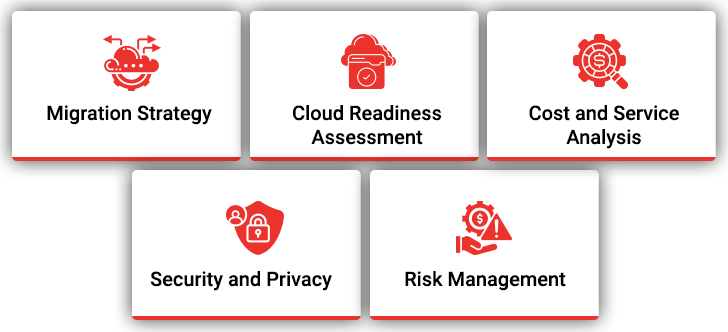Today businesses across all industries are viewing Cloud computing as a key enabler of business transformation. Organizations are moving towards different types of Cloud migration to improve customer engagement, forge new partnerships, save cost, and get a competitive edge. However, migration to Cloud computing is a complex process that requires careful planning and execution.

Few Facts:
- According to Gartner research, more than 70% of companies have migrated at least some workloads into the public cloud.
- A recent study conducted by Zippia reveals that 92% of businesses have a multi-cloud strategy in place.
- The study also indicates that 94% of enterprises use cloud services and 67% of enterprise infrastructure is now cloud-based.
- According to Fortune Business Insights, the IaaS market size is estimated to reach 531.84 billion USD by 2030.
5 Key Considerations for Cloud Migration to Take Into Account

1. Migration Strategy
A Cloud computing migration strategy must begin with a thorough assessment, research, analysis, and collaboration with all the departments to determine which applications and workloads can streamline business operations and enhance office productivity. A solid migration strategy defines the current state and further establishes the benefits of migration to Cloud computing to not only reduce costs but also deliver meaningful business value.
Preparing to Migrate to the Cloud
2. Cloud Readiness Assessment
A detailed assessment of applications for Cloud readiness enables organizations to determine what applications can be readily moved to a Cloud environment. Alternatively, it also sheds light on the applications you do not want to move to the Cloud. The Cloud migration consideration assessment must include data, technology, security, integration, and application architecture.
3. Cost and Service Analysis
After deciding on an application for migration to the Cloud, a detailed Cloud migration cost analysis must be executed. Enterprises need to consider a few questions before taking the plunge.
- What is the ongoing Cloud service cost?
- Is the service management and license management cost too high?
- What is the application maintenance and administration cost?
- How about application deployment and testing?
Additionally, it is equally imperative to make certain that the level of service provided by the Cloud-based application will be equivalent to current service levels.
Foolproof Strategy to Measure the ROI of Cloud Migration
4. Security and Privacy
Security and privacy are two of the major concerns of Cloud service customers. Enterprises need to be mindful of the different types of data used throughout the service to be migrated to ensure compliance with regulatory requirements and internal policies. Data needs to be encrypted, user accounts need to be isolated from each other, and cross-access must be closely controlled. Enterprises should actively decide on appropriate security measures for each data type, to manage related risk and any compliance issues that may arise.
5. Risk Management
Risk management is critical to ensure a smooth migration to the Cloud while minimizing the impact of any potential threats or uncertainties. Organizations need to identify the specific risks involved in migrating workloads, applications, and data to the Cloud platform, which may include service interruptions, data breaches, compliance issues, and unexpected costs. Once the risk identification process is completed, a comprehensive assessment needs to be done to prioritize and determine the potential impact of each risk. Following the risk assessment, mitigation strategies need to be implemented to address the identified risks. This may involve establishing contingency plans for unexpected downtime or data loss, implementing stringent security measures, and ensuring compliance with industry regulations.
Summing Up
The decision to embark on a journey of migrating workloads and applications to the Cloud is not merely a technical shift but a commitment to embracing resilience, scalability, and innovation. As we conclude this detailed exploration into cloud migration, it’s evident that this expedition is not without its challenges and demands meticulous planning, vigilant risk management, and a deep understanding of organizational objectives. This is where the need for a Cloud migration expert comes in. By partnering with a reliable company, you can not only overcome the challenges that come along the way but also set sail for success.
Case in Focus
A leading property management and investment company having a strong presence across major cities and towns in the United Kingdom needed help in managing the peak load variation. The client turned to Damco Solutions to overcome this challenge. Based on the assessments and compatibility tests conducted by experts, they chalked out a strategic roadmap for application migration from on-premises to the cloud in a phased manner. By migrating workloads and applications to the cloud, the client decommissioned 20 UAT (User Acceptance Testing) servers, improved system efficiency by 43%, reduced costs by 29%, and increased customer acquisition and retention by 15%. Read the detailed case study to discover how cloud-based migration helped the client in ensuring continuous improvements in service to its clientele.





